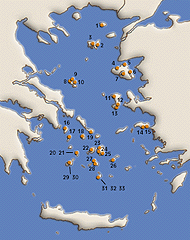In contradiction to the Early Bronze Age, the archaeological remains of the
Middle Bronze Age on the Aegean islands are until now restricted and allow only a
first approach of the settlement, economic and social organization of the insular communities of
this period.
In the northeastern Aegean islands, early urban centres of the
Early Bronze Age such as Poliochni on Lemnos and Thermi on Lesbos are re-occupied after
several hundreds of years but without reacquiring their previous glory.
Conversely, settlements such as Mikro Vouni on Samothrace and Koukonisi of Lemnos are
interruptedly inhabited and experience population growth, building expansion and
economic prosperity which is due mainly to their position on sea trade routes linking
the Black Sea and Asia Minor with the central Aegean, the Greek mainland and Crete.
During the Middle Cycladic period, after a brief interruption
due to natural disasters (earthquake) or other causes, the large Early Cycladic III
settlements, such as Phylakopi on Melos, Agia Irini on Keos and Akrotiri on Thera
are reoccupied. Under the influence of powerful Minoan Crete, these settlements experience
economic prosperity and are developed into urban centres which maintain their power
during the Late Cycladic period as well. Apart from the coastal sites, naturally fortified
sites as Vryokastro on Tinos, Kastri on Siphnos, Kastri on Amorgos and Mikri Vigla on Naxos
are also inhabited.
|
 |